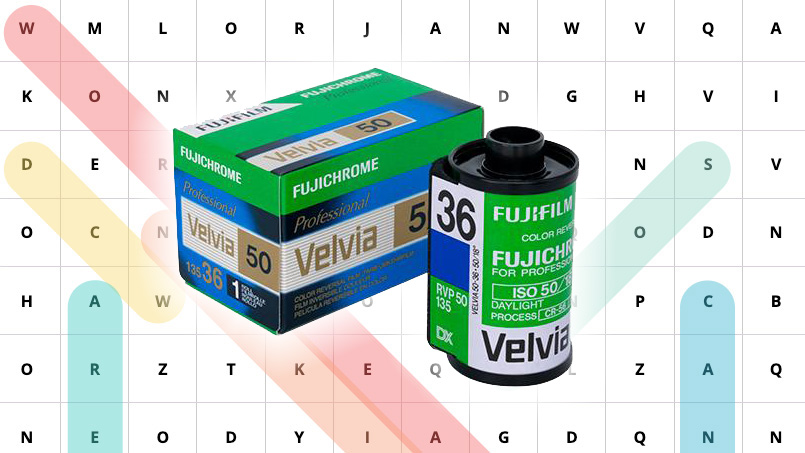This astronaut's incredible photo, taken from space, features in the Milky Way Photographer of the Year collection
Explore Capture the Atlas' stunning collection and uncover the gear behind these breathtaking astrophotos
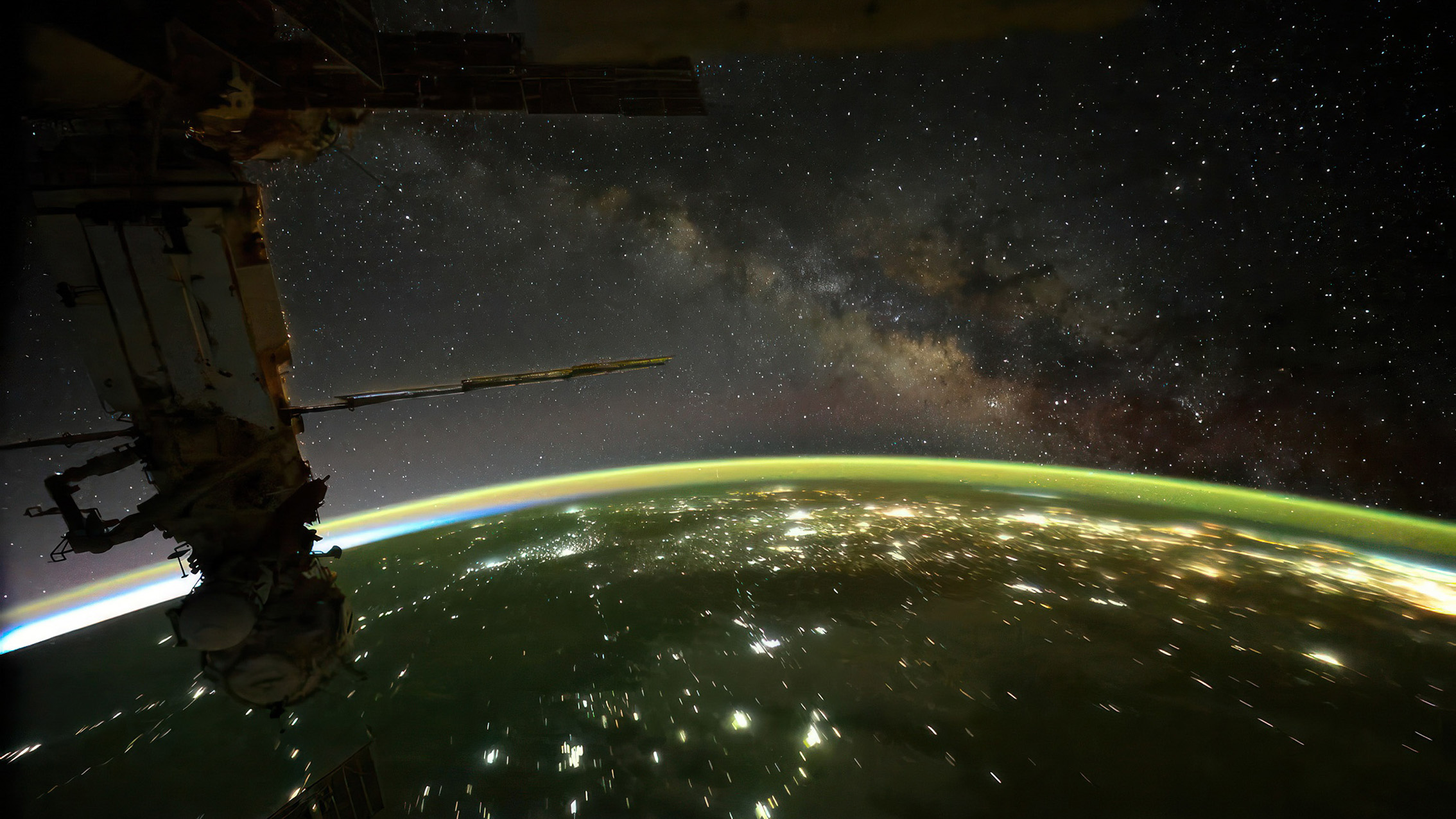
The travel photography blog Capture the Atlas has released the eighth edition of its annual Milky Way Photographer of the Year, showcasing a curated collection of the 25 best Milky Way photos around the globe.
And – for the first time ever – the collection includes a shot taken from space.
Described by Capture the Atlas as an "extraordinary milestone," the image One in a Billion, was captured by NASA astronaut Don Pettit aboard the International Space Station.
Astrophotography is among the most challenging genres in photography. Increasing light pollution only adds to the difficulty of capturing the night sky in all its clarity and vibrancy.
That's also why many of this year's images come from some of the most remote and pristine locations on Earth – from the deserts of Cha and the peaks of the Andes to the surreal landscapes of Socotra Island and the untouched skies of New Zealand and Namibia.
This year's collection also includes striking captures of celestial events: a comet, a meteor shower and a lunar eclipse, each beautifully set against the glowing backdrop of the Milky Way.
So, let's dive into ten standout images, explore the stories behind the stills and take a look at the gear that made these awe-inspiring shots possible. Because in astrophotography, the right equipment makes all the difference.
The best camera deals, reviews, product advice, and unmissable photography news, direct to your inbox!
To view the full gallery, head over to Capture the Atlas' website.
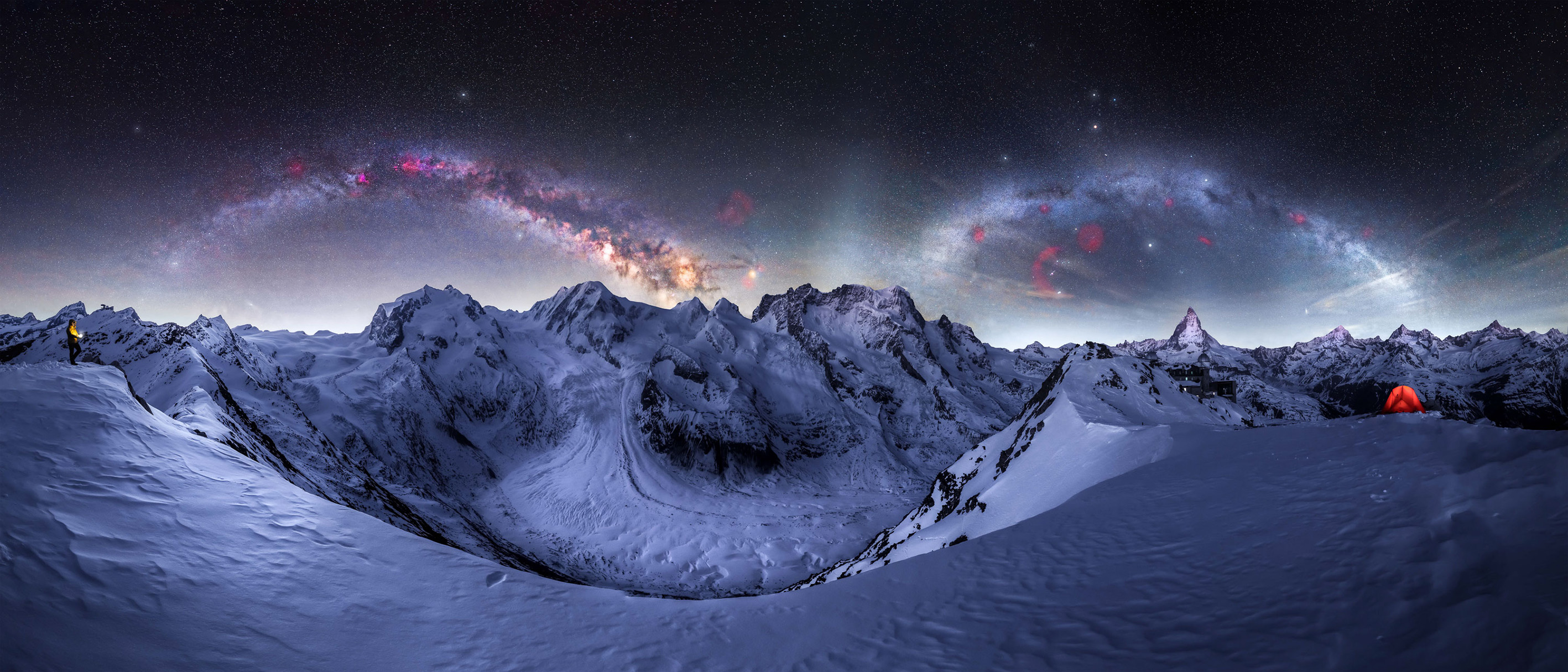
Double Milky Way Arch Over Matterhorn by Angel Fux
Image info
- Both arches: f/5.6, 127 sec, ISO 2500
- Foreground: f/5, 1/5 sec, ISO 800
Gear info
-Nikon Z6 Astromodified (for the sky part)
-Nikon Z 20mm f/1.8 S
- Nikon Z8 (for the landscape part)
- Nikon Z 14-24mm f/2.8 S
- Benro Polaris Astro Kit
- Peak Design travel tripod
"This image captures the rare Double Arch Milky Way, where both the Winter Milky Way (with Orion rising) and the Summer Milky Way (with the Galactic Center) appear in the same night – a seamless transition between seasons.
"Taken at 3,200 meters in the heart of winter, the night was brutally cold, testing both my endurance and equipment. This is a time blend, preserving the real positions of both arches by combining frames taken hours apart, with the foreground captured at dawn for the best detail.
"Zermatt and the Matterhorn have been photographed countless times, but I aimed to create something truly unique – an image captured under conditions few would attempt. I'm incredibly proud of the effort and patience it took to bring this vision to life."
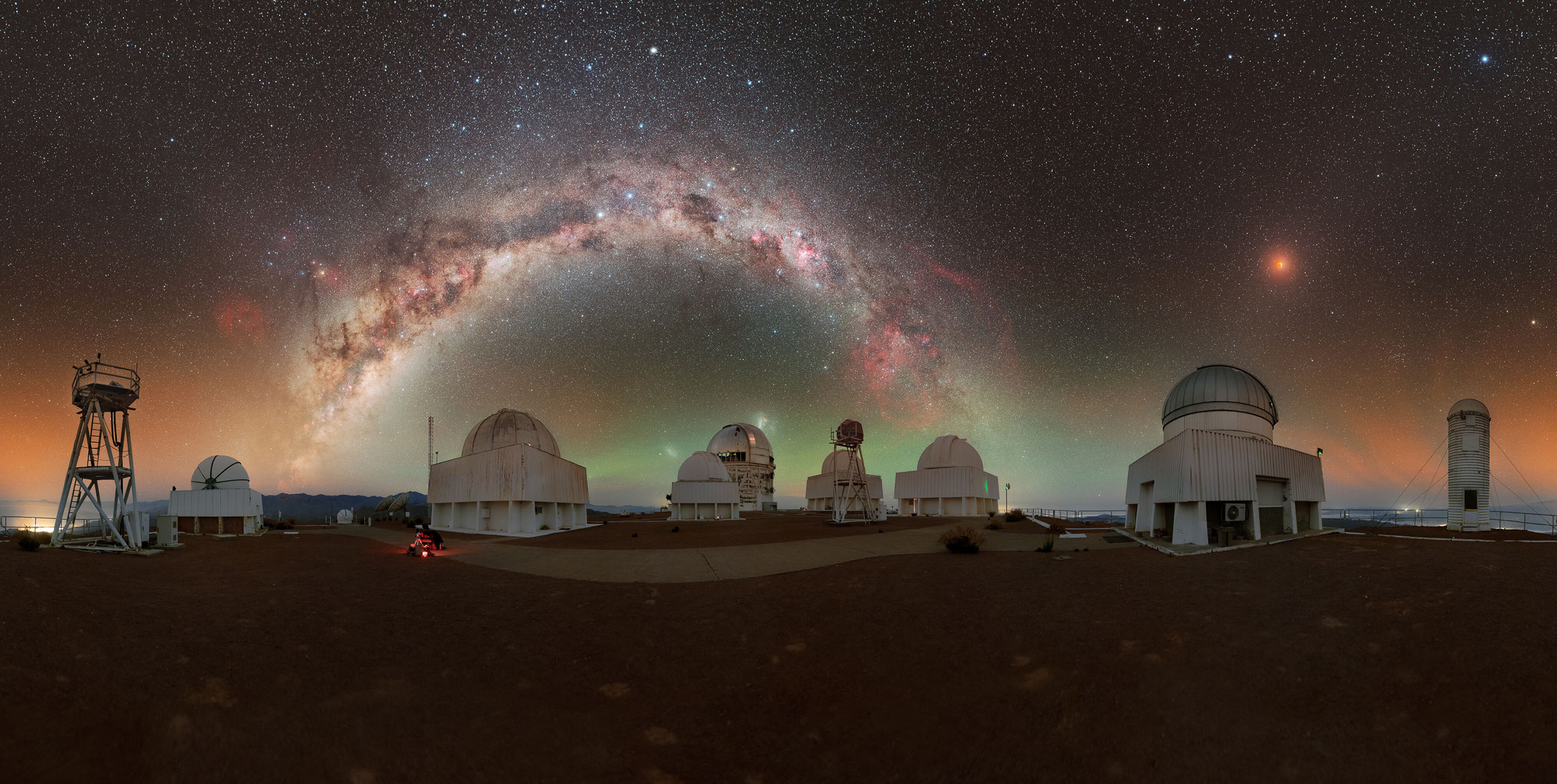
Tololo Lunar Eclipse Sky by Petr Horálek
Image info
- Single exposures stitched to a panorama
- f/1.8, 81x10 sec, ISO 8000
Gear info
- Canon EOS Ra
- Sigma Art 35mm f/1.8
"On March 14 2025, a total lunar eclipse occurred, especially visible over the Americas and the Pacific Ocean. I was fortunate to observe this particular eclipse from the NSF Cerro Tololo Inter-American Observatory in Chile. You can see how epic the sky was during totality, as the Moon darkened enough for the majestic Milky Way, the faint belt of Zodiacal Light, and prominent airglow to stand out."
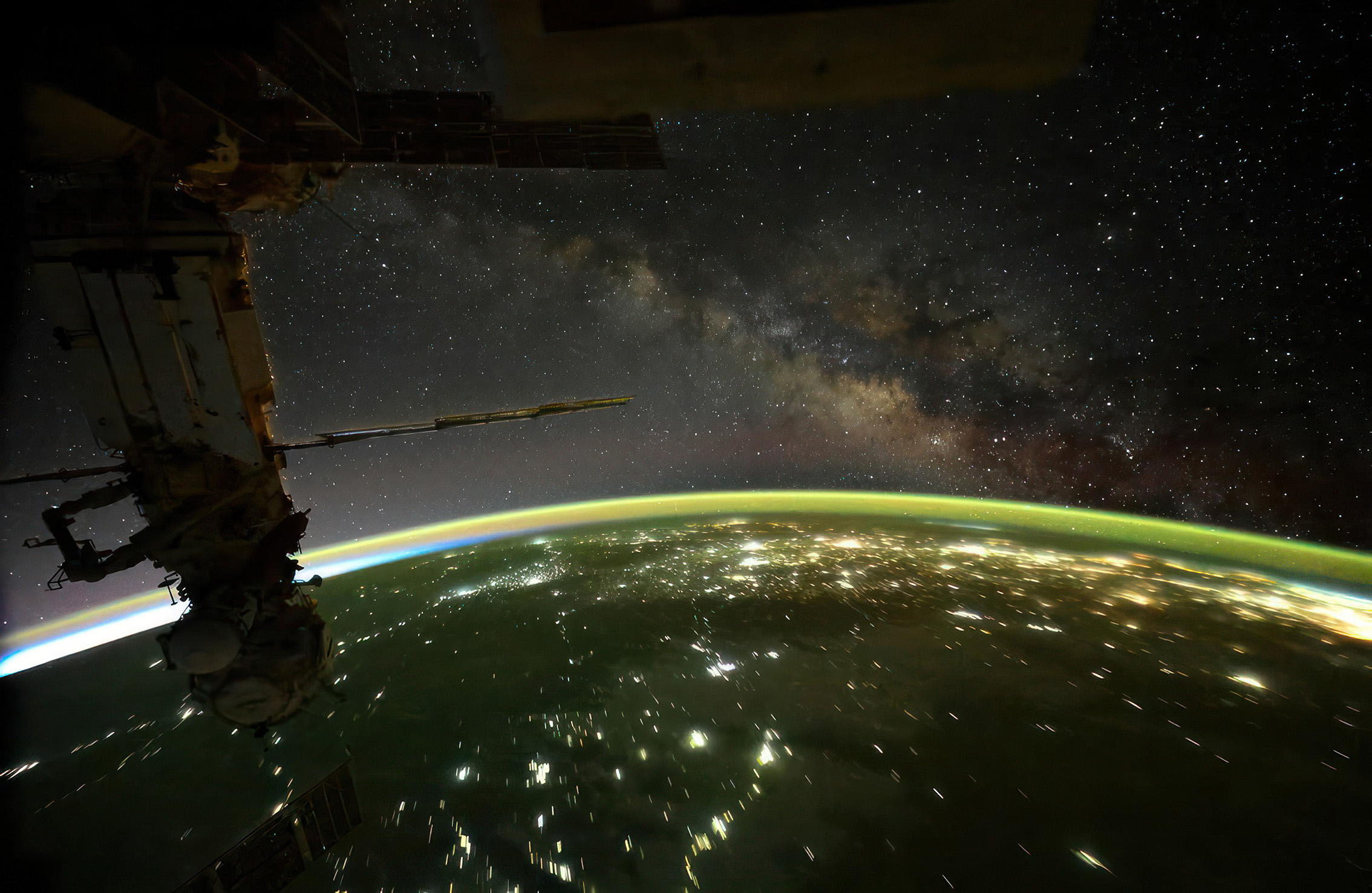
One in a Billion by Don Pettit
Image info
- 14mm, f/1.4, 8 sec, ISO 6400
Gear info
- Nikon Z9
- Sigma 14mm f/1.4 DG DN Art
- Sky Watcher modified tracker
"I float in the Cupola, looking out the seven windows composing this faceted transparent jewel. While my mind is submerged in contemplation, my eyes gorge on the dim reflections from a nighttime Earth.
"There are over eight billion people that call this planet home. There are seven of us that can say the same for Space Station. What a privilege it is to be here. I used an orbital star tracker to take out the star streak motion from orbit."
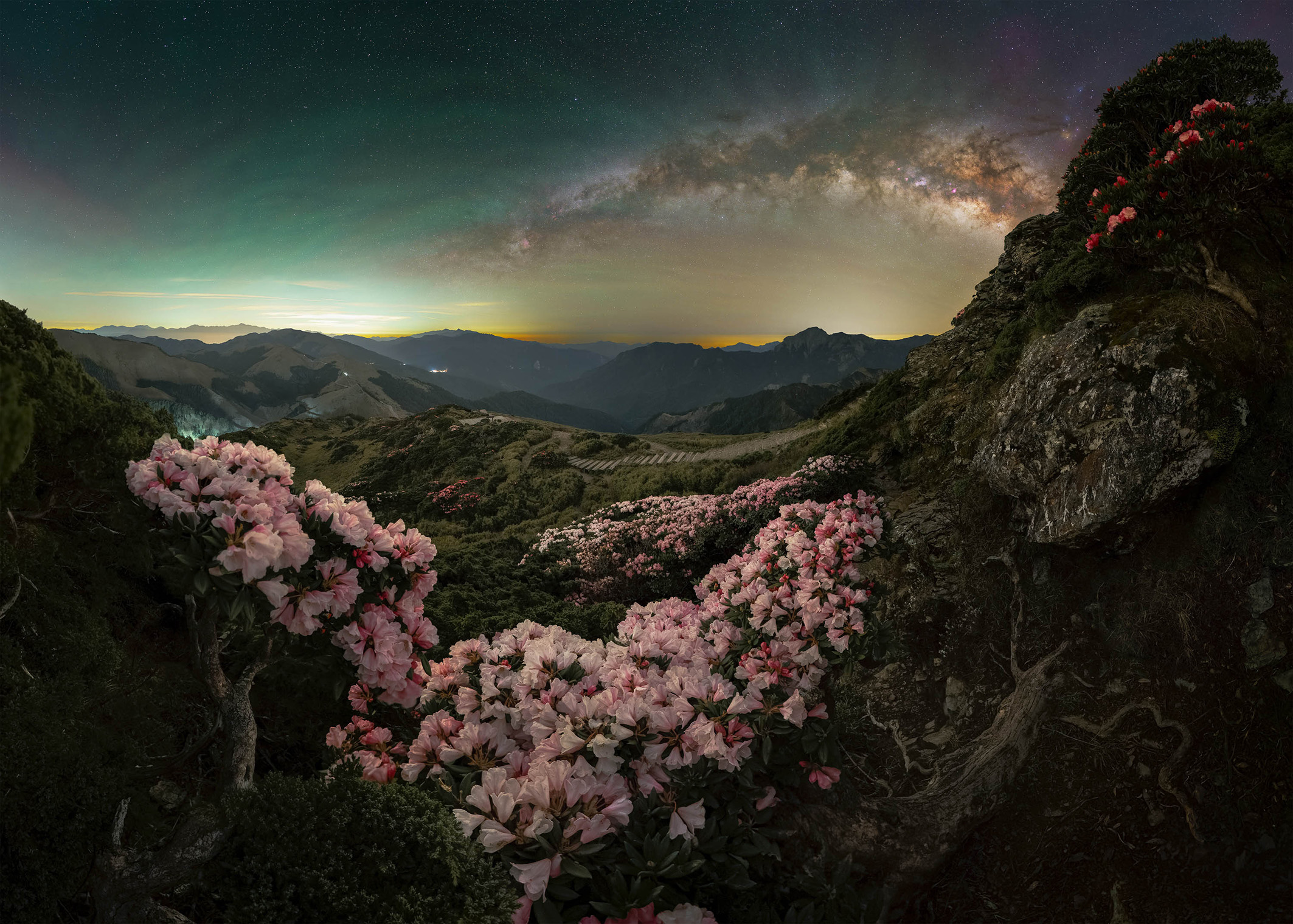
Blosoom by Ethan Su
Image info
- Sky: 1 row tracked panorama at f/2, 90 sec, ISO 800
- Foreground: 2 row panorama and focus stack, f/2.8, 60 sec, ISO 6400
- 65 images in total
Gear info
- Sony A7 III (astromodified)
- Sigma 20mm f/1.4 DG DN Art
- Vixen Polarie U
- Leofoto LS-284cex tripod
"After 3 years of waiting, the Yushan alpine rhododendrons are finally in bloom once again on Taiwan’s 3,000-meter-high Hehuan Mountain. On this special night, distant clouds helped block city light pollution, revealing an exceptionally clear view of the Milky Way.
"A solar flare from active region AR3664 reached Earth that evening, intensifying the airglow and adding an otherworldly touch to the sky. Together, these rare natural events created a breathtaking scene – vivid blooms glowing softly beneath a star-filled sky."
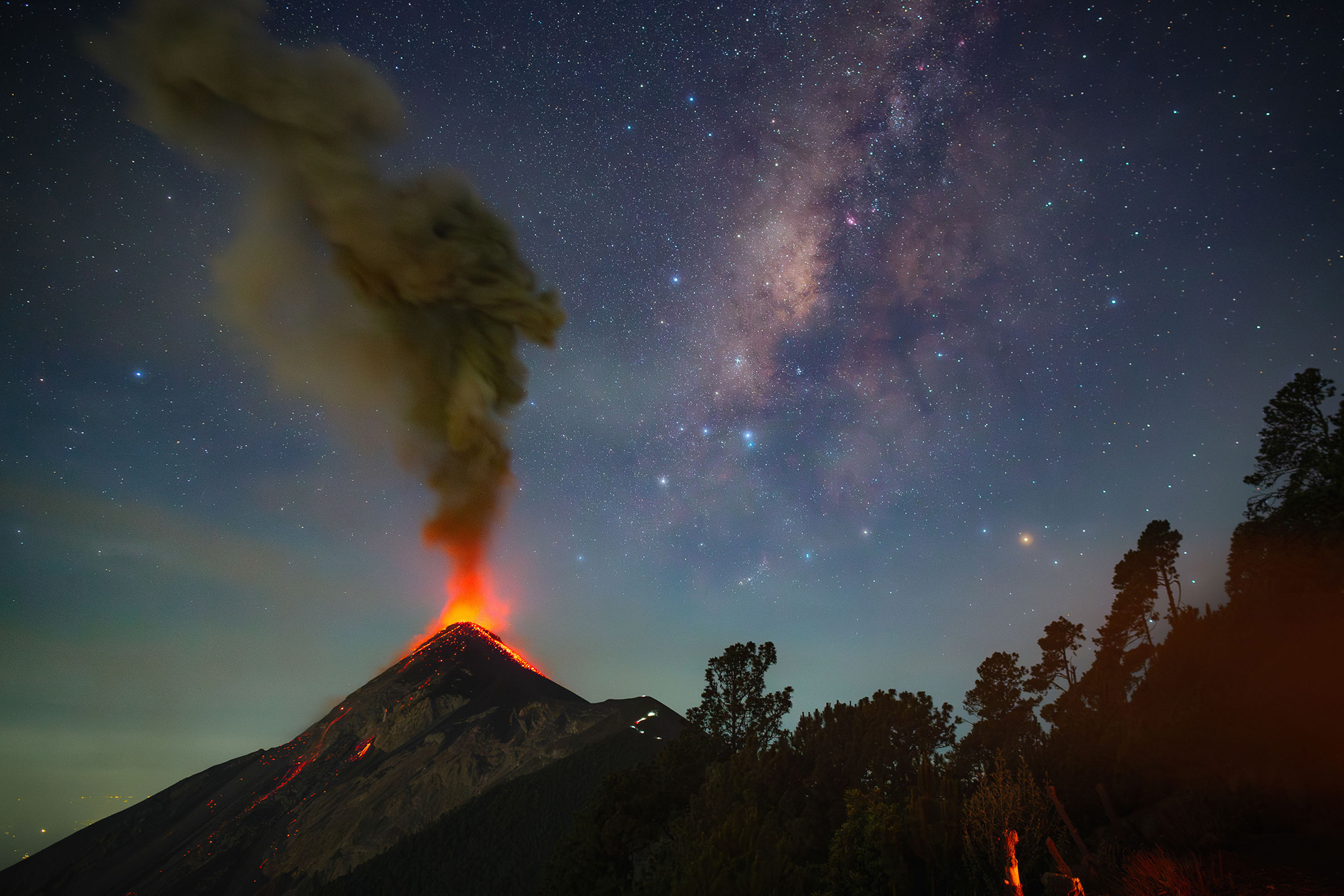
Cosmic Fire by Sergio Montúfar
Image info
- Single image, f/2.8, 10 sec, ISO 3200
Gear info
- Canon 6D Astromodified
- Samyang/ Rolinon 24mm f/1.4 ED AS IF UMC
- Sirui tripod
"On the early morning of June 02 2024, I summited Acatenango Volcano for the first time, hoping to witness the fiery beauty of the neighboring Volcan de Fuego against the Milky Way’s backdrop. That night, the volcano was incredibly active – each thunderous explosion reverberated in my chest, while glowing lava illuminated the dark slopes.
"Above, the Milky Way stretched diagonally across the sky, a mesmerizing band of stars contrasting with the chaos below. As the volcano erupted, the ash plume rose vertically, forming an acute angle of about 45 degrees with the galaxy’s diagonal path, creating a stunning visual contrast between Earth’s fury and the cosmos’ serenity.
"Capturing this required a fast, wide-angle lens (f/2.8), an ISO of 3200, and a 10-second exposure to balance the volcanic glow with the starlight. The challenge was timing the shot during a new moon and aligning the right moment for the Milky Way to cross the frame next to the volcano. I used Lightroom as the editor.
"This image is special for its storytelling – the raw power of Volcan de Fuego meeting the tranquil expanse of the galaxy."
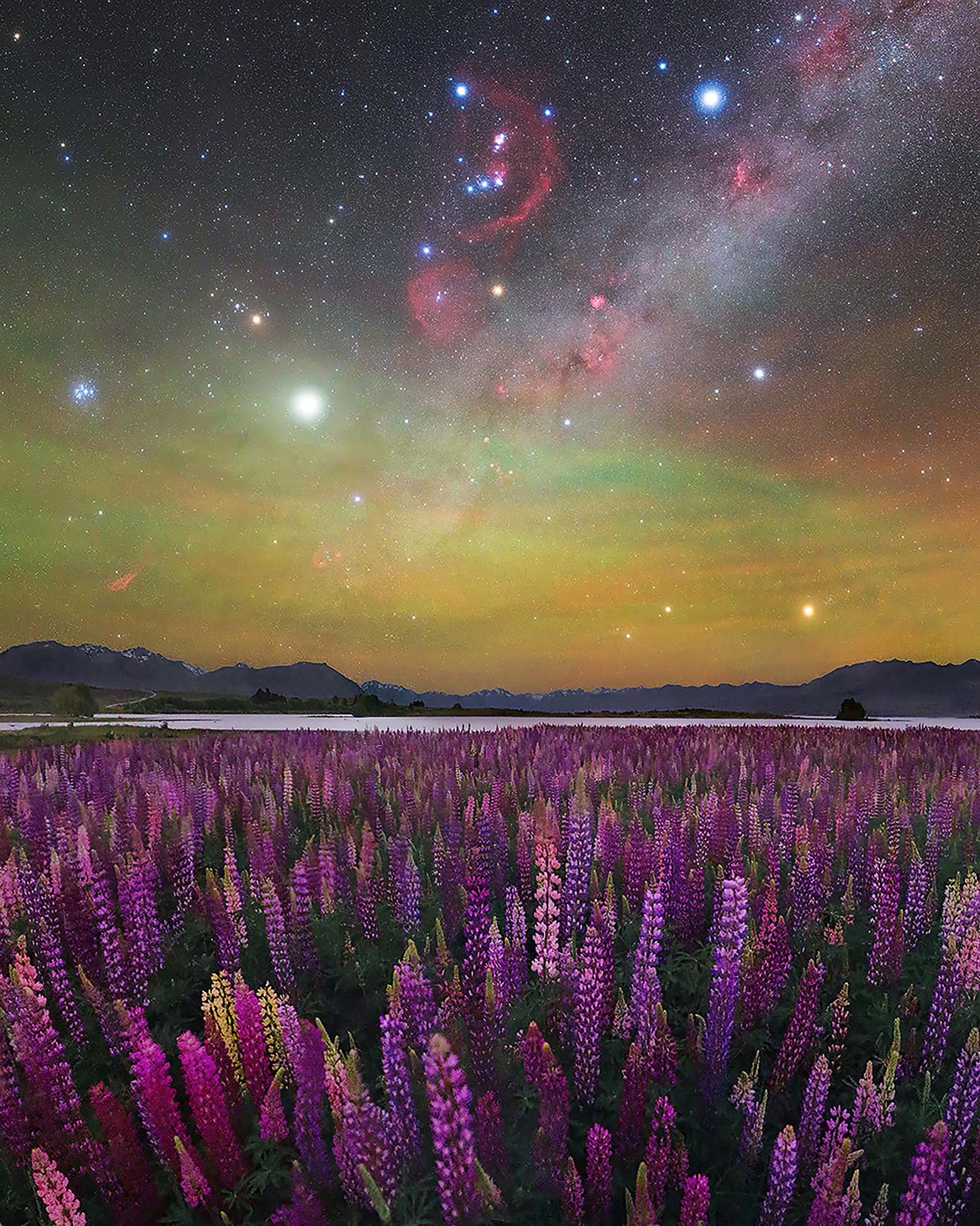
A Sea of Lupines by Max Inwood
Image info
- Sky: f/2.0, 30 sec, ISO 3200
- Foreground: f/2.4, 30 sec, ISO 6400
Gear info
- Canon EOS 6D (astromodified)
- Sigma 28mm f/1.4 Art
- Samyang 14mm f/1.4 XP
- iOption SkyGuider Pro
"The annual lupine bloom in New Zealand is spectacular, with fields of colorful flowers stretching across the Mackenzie Basin. This region, located in the heart of the South Island, is renowned for its dark skies, making the scene even more surreal at night.
"I had to wait until the early hours of the morning for the wind to calm down, but eventually everything became still, and I was able to capture this image.
"Above the flowers, you can see the band of the outer Milky Way, alongside the constellations Orion, Gemini, and the Pleiades. Joining them are the bright planets Jupiter and Mars, with a strong display of green airglow visible along the horizon."
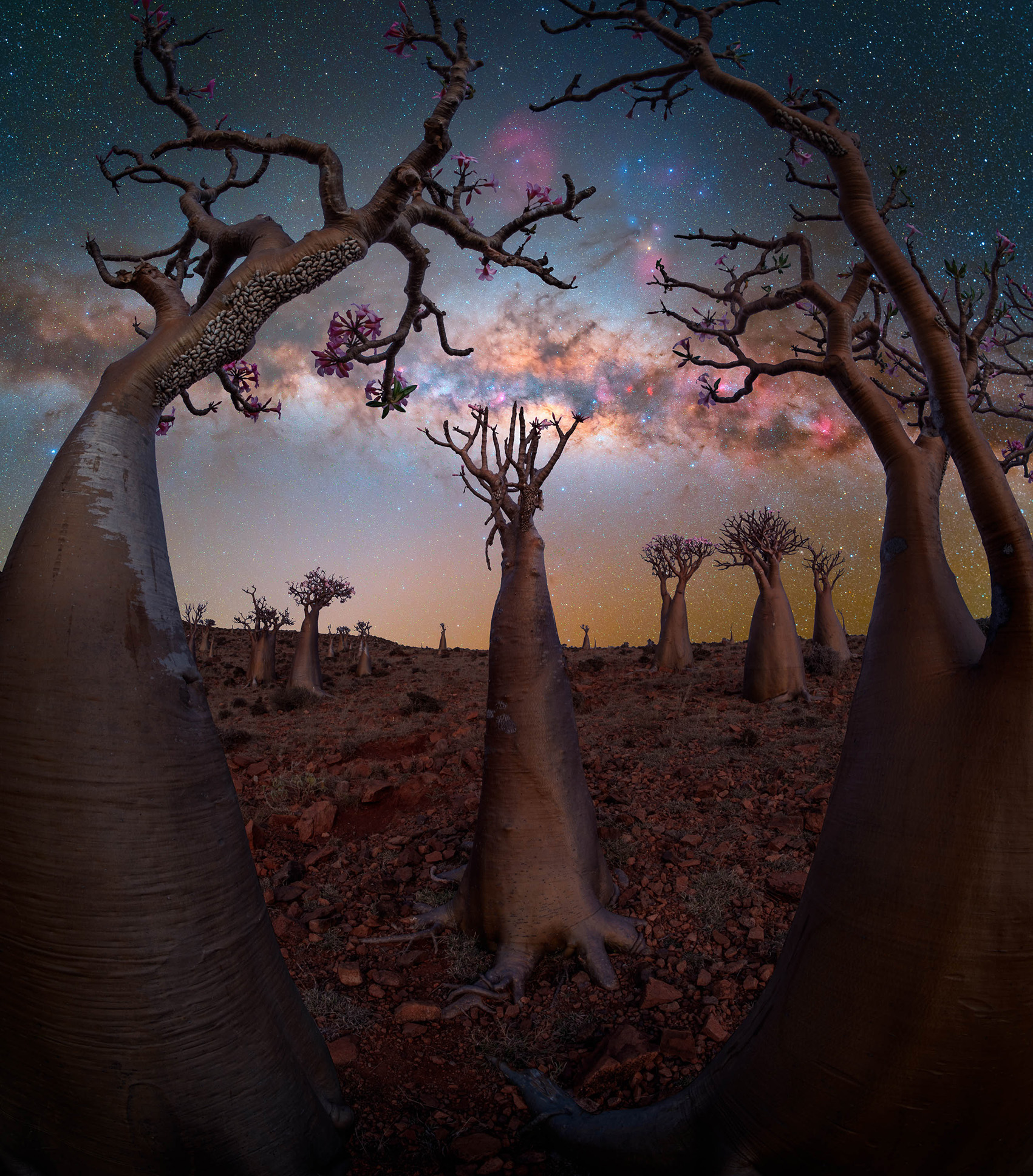
Bottle Tree Paradise by Benjamin Barakat
Image info
- Foreground (blue hour): f/8, 10 sec, ISO 400
- Sky: f/2.0, 5x120 sec, ISO 400
Gear info
- Sony A7 IV
- Sony FE 14mm f/1.8 GM
- Sunwayfoto T2840CK
- MSM Nomad
"Socotra is one of my favorite places on Earth, but when it comes to a specific location, this one stands out. It doesn’t have an official name, as it’s not a destination for the few fortunate tourists who visit Socotra. After shooting there for the past four years and scouting the island, I’ve discovered hidden gems like this one, which I call Bottle Tree Paradise.
"Bottle trees are unique to Socotra, a result of the island’s long isolation from the mainland. This separation allowed them to evolve distinctive features, such as their water-storing, bottle-shaped trunks, which help them survive Socotra’s harsh, dry climate. They are believed to have originated from ancient plant species that adapted to the island's unique environment over millions of years."
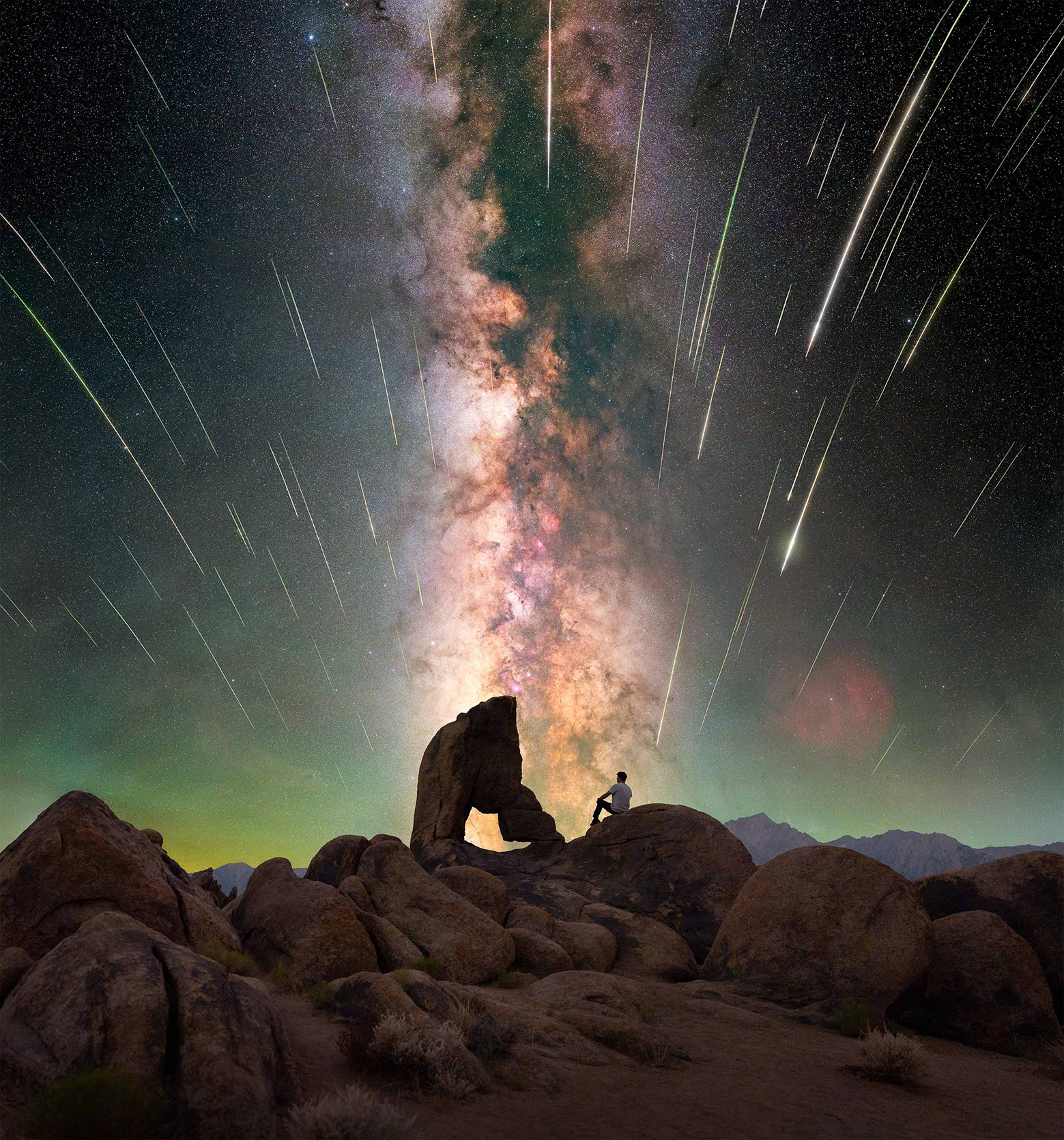
Boot Arch Perseids by Mike Abramyan
Image info
- Sky: Mosaic of 9 images at 50mm, f/2, 92 sec, ISO 400
- Foreground: Mosaic of 4 images at 50mm, F/2.8, 92 sec, ISO 400
- Meteors: 14mm, f/1.8, 15 sec, ISO 400
Gear info
- Sony A7 IV (astromodified)
- Sony FE 50mm f/1.2 GM
- Sony FE 14mm 1.8 GM- Benro Polaris
- Leofoto LS-324C
"The Perseid Meteor Shower occurs every August, raining down hundreds of meteors over a few nights. In 2024, I had planned to photograph it from the Canadian Rockies, but wildfires forced me to change my plans at the last minute. After checking wildfire maps, I found a safe haven in the Eastern Sierra Nevada.
"After three full nights of capturing meteors, I created this image. Sitting on the rock is my friend Arne, who often joins me on these adventures, gazing up at the magnificent core of our galaxy.
"Each meteor is painstakingly aligned to its true location in the night sky. The final depiction shows all the meteors I captured, combined into one frame – as if the Earth hadn’t been rotating and all the meteors had fallen at once."
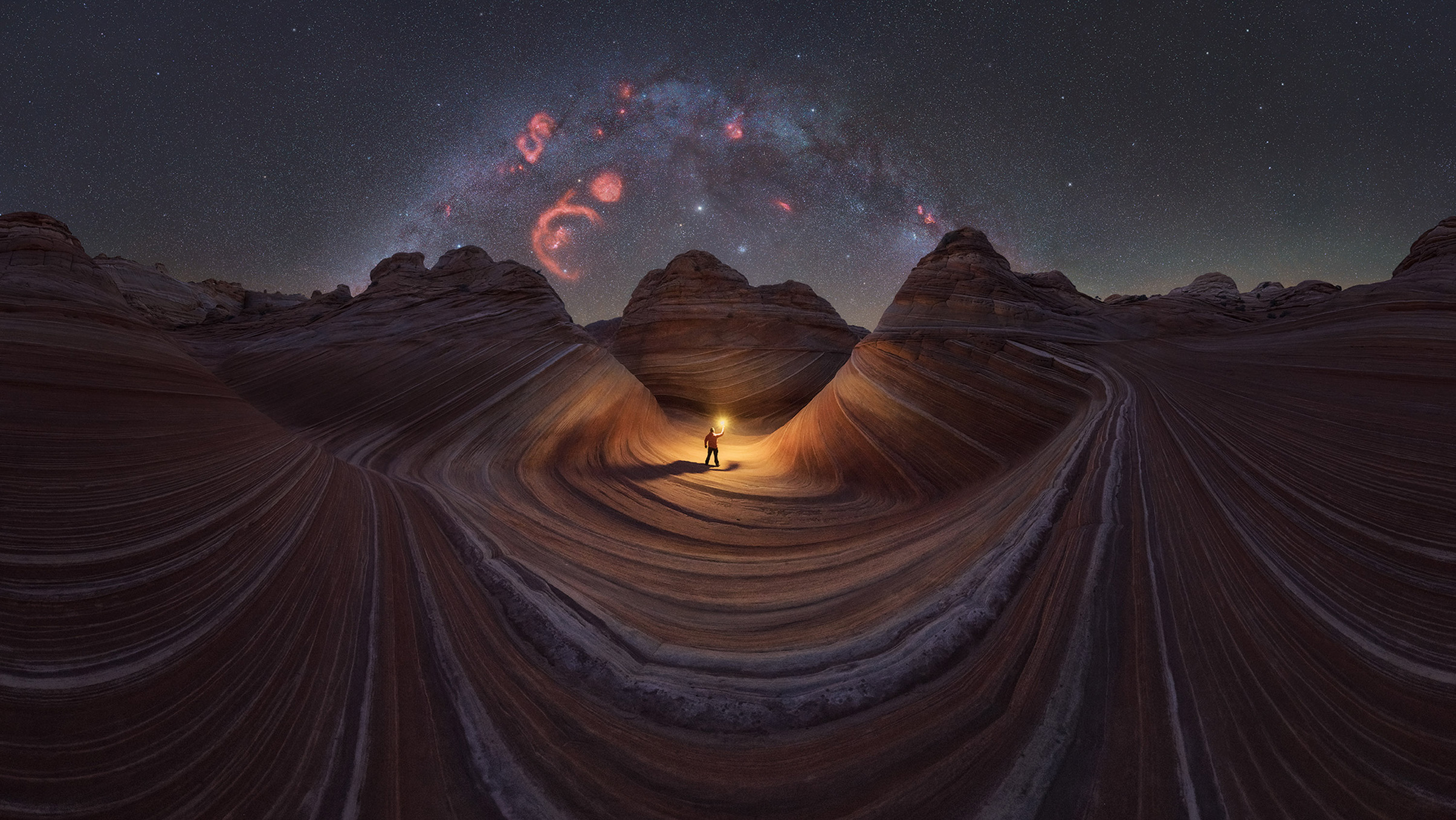
The Wave by Luis Cajete
Image info
- Foreground: 360° panorama, two rows, f/3.5, 8 sec, ISO 6400
- Sky: 360° panorama, two rows, f/1.8, 60 sec, ISO 800
- Sky H Alpha: three-shot panorama, stacked, f/1.8, 240 sec, ISO 1600
Gear info
- Nikon Z6 II
- Samyang/ Rolinon 12mm f/2.8 ED AS NCS Fish Eye
- Nikon Z6 (astromodified)
- Nikon Z 20 mm 1.8
- Astronomic filter H-alpha 12nm
- iOption Skyguider pro
- Leofoto LS324C tripod
"One of my greatest passions is visiting stunning natural wonders and paying my personal tribute to them through night photography. This image was taken at Coyote Buttes, a geological masterpiece located in Arizona, where special access permits are required to protect it for future generations.
"Despite the intense cold during those days, it was incredibly exciting to visit the great sandstone wave for the first time and enjoy its spectacular shapes and colors.
"To capture this 360° panorama, I planned for the Milky Way and focused on creating a balanced photographic composition. It’s hard to put into words the beauty of this place, but I hope my photograph manages to convey it."
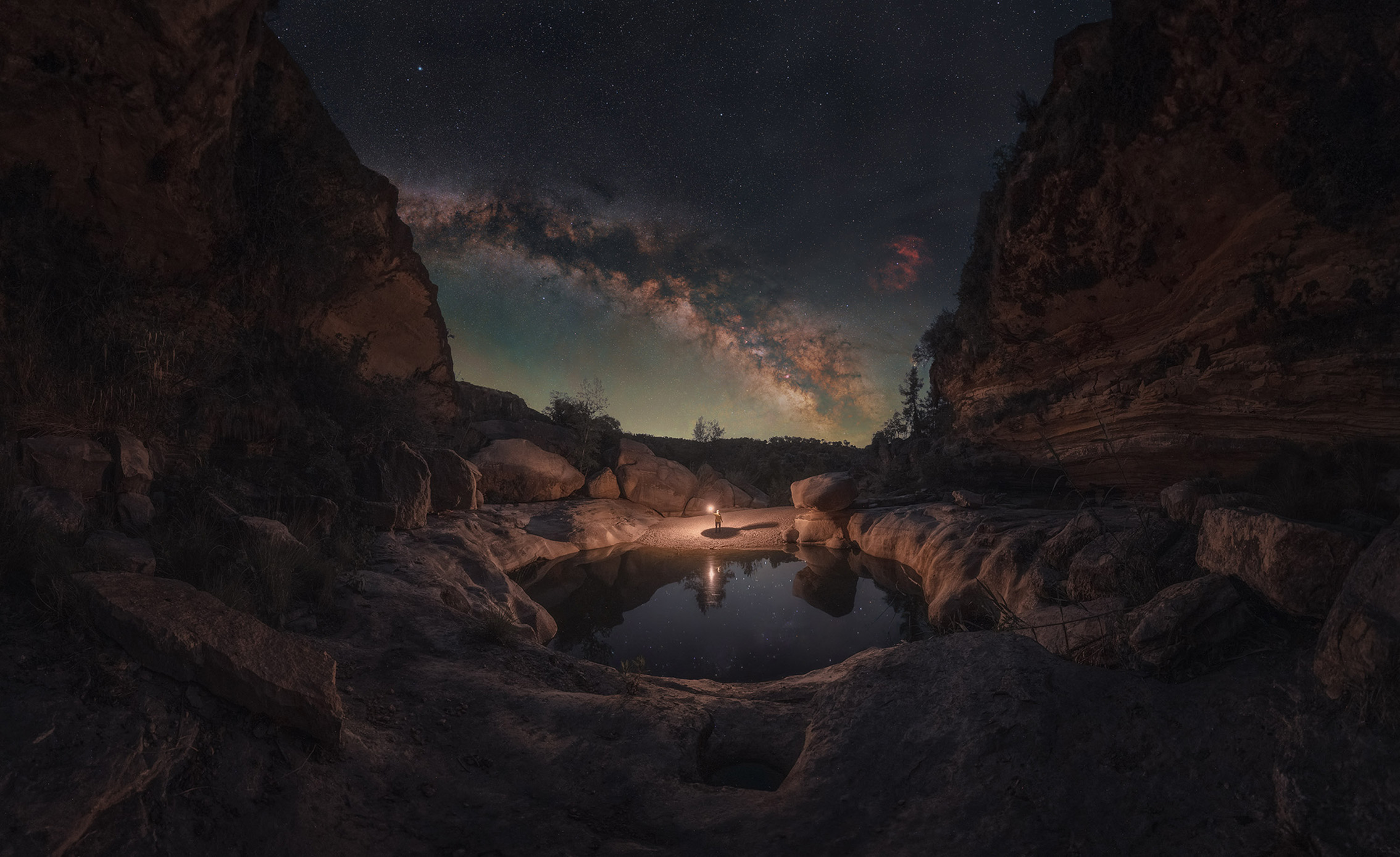
Un Destello en la Oscuridad by Luis Merino
Image info
- Sky: 1 row, 4 panel x 5 shots per panel, f/1,4, 25 sec, ISO 1600
- Foreground: 1 row, 3 panels, f/2.8, 120 sec, ISO 6400
Gear info
- Sony A7 III Astromodified
- Sigma 24mm f/1.4 DG HSM Art
- Samyang 8mm f/2.8
- Benro Polaris
"In my quest to find new places to practice this beautiful hobby, I discovered this corner, which, with a touch of light, transformed into a dreamlike scene. The lighting highlighted every detail: a stream carved by water, which usually flows forcefully after heavy rains, was now a peaceful calm; and although the Milky Way didn’t fully unfold, the galactic center appeared framed like a radiant beacon in the vastness of the night sky.
"The gentle croak of the frogs provided the natural soundtrack to this experience, making each moment feel unique and filled with magic. This experience taught me that light has the power to transform the ordinary into a scene of wonder, revealing nuances that would otherwise go unnoticed."
If you are feeling inspired to start or dive deeper into astrophotography, Capture the Atlas offers tutorials, travel guides, and curated content to help you gain or refine your skills.
You might also like...
Capturing stunning images of the night sky and space starts with having the right gear. Check out our guides to the best cameras for astrophotography and the best lenses for astrophotography.

Kim is a photographer, editor and writer with work published internationally. She holds a Master's degree in Photography and Media and was formerly Technique Editor at Digital Photographer, focusing on the art and science of photography. Blending technical expertise with visual insight, Kim explores photography's time-honored yet ever-evolving role in culture. Through her features, tutorials, and gear reviews, she aims to encourage readers to explore the medium more deeply and embrace its full creative potential.
You must confirm your public display name before commenting
Please logout and then login again, you will then be prompted to enter your display name.
